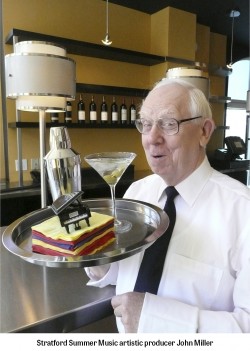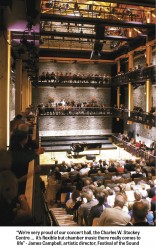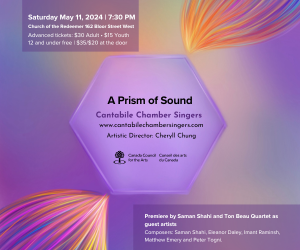 The summer music festival can be a bit of a mystifying concept. At just the time of year when you would expect most concert performers to pack up their instrument cases and head to the cottage, there is, across the country, a sudden eruption of summer music-making branded as “festival season” – a phenomenon often put together by people who work throughout the year and around the clock to make it happen. And yet, despite all the similarities (weekend getaways, specially-themed concert series, multi-arts celebrations and educational initiatives), you’d be hard-pressed to find two festivals in any given summer that appear to be cut from the same cloth.
The summer music festival can be a bit of a mystifying concept. At just the time of year when you would expect most concert performers to pack up their instrument cases and head to the cottage, there is, across the country, a sudden eruption of summer music-making branded as “festival season” – a phenomenon often put together by people who work throughout the year and around the clock to make it happen. And yet, despite all the similarities (weekend getaways, specially-themed concert series, multi-arts celebrations and educational initiatives), you’d be hard-pressed to find two festivals in any given summer that appear to be cut from the same cloth.
So what exactly is a summer music festival, and, apart from the fact that it’s in the summer, what are some of the factors that give each its unique fingerprint – keeping audiences and organizers alike coming back for more? Make no mistake – increasingly, music festivals are more than just blips on the regular musical calendar. These summer events have a particular capacity for going above and beyond the constraints of the average concert series, offering up an experience that is not only carefully curated but musically unique. And who better than some of the people who do that curating to talk about the unique characteristics of the festivals they shepherd into being?
Panamania: As Toronto counts down to the summer’s Pan Am and Parapan Am Games, Don Shipley has been hard at work as the Games’ creative director of arts and culture, spearheading the accompanying cultural event christened Panamania. And with over 250 performances and exhibitions featuring music, theatre, dance, art and fashion between July 10 and August 15, it’s safe to say that Panamania has been keeping him busy.
Says Shipley: “For me it’s been a wonderful journey because it was part of my own discovery too, digging into the music of the Americas, unearthing not only what is best from these countries, but sometimes their best kept secrets. I think quite honestly that the marquee names people will know, but the real discoveries sitting at one of our three venues are those artists they won’t already know.”
Those names include, among hundreds of artists and musicians, such performers as the Flaming Lips, Jann Arden, Blind Boys of Alabama, Calle 13, Bomba Estéreo and Lila Downs, as well as the YOA Orchestra of the Americas – a special youth orchestra project that will bring together orchestral musicians aged 18 to 30 from across the Americas. In even this single festival alone, there will be no shortage of musical celebration in Toronto over the coming summer.
“It’s that whole sense of large public engagement. It’s really about that whole shared experience,” Shipley explains. “People by nature just love large gatherings. They love to be together, they love that communal experience – and I think what we’ve got here is not only a legacy of introducing great music, but it’s also about that big gathering of people coming together to celebrate.”
Music at Port Milford: The gathering of people for a musical and celebratory purpose can of course take many different forms. While Panamania, as a one-time-only whirlwind, blows through Toronto, outside the city Music at Port Milford breezes into Prince Edward County, as it has done every summer for 28 years. Music at Port Milford is a strikingly different kind of summer festival experience. A chamber music festival and summer camp program running this year from July 12 to August 9 for ages 12 to 18, it is founded on the importance of community. “My original vision 28 years ago was to bring students together in a family-like atmosphere and really make the program a more holistic experience,” says Meg Hill, who co-founded the camp on her family farm and now acts as the program’s director. “We don’t just have teachers coming in and giving classes, the same people who are coaching you are also playing chess with you, and playing Bananagrams with you, and eating spaghetti with you – so it’s very family-like in that sense.”
For Hill, seeing the first moments of that family coming together are part of what makes organizing the festival worthwhile. “I look forward to and get excited for the first day of each session. We have students coming from really all over, from Mexico City to Alberta, and even though it’s only about 40 kids they all come from such different places. It’s really exciting to see the first meal, just to see all of these people coming in from all over the place and figure out how we’re going to create a community,” she recalls. “The students also all sing together, even though they’re not singers – the first night after our first meal, they’re in the barn and they’re singing together – and I’m somewhere out in the field listening, and that’s a wonderful moment that I look forward to every year.”
Stratford Summer Music: For those willing to venture to venues beyond the GTA like Prince Edward County, this summer promises no shortage of unique concertgoing opportunities. In addition to the output of educational programs like Music at Port Milford, a number of the province’s now-staple summer festivals not only consistently have exciting performers and programs on their rosters, but have a consistent feel to their programming, reflective of the individual running the show.
Less than a two-hour drive from Toronto in Stratford, Ontario, Stratford Summer Music’s artistic producer John Miller has put together an eclectic mix of concerts to commemorate their 15th anniversary year, among them tributes at dawn and dusk to the music of R. Murray Schafer, brunch shows featuring violinists culled from Tafelmusik, Ben Heppner in recital with the Blind Boys of Alabama and a “Classical Tattoo” featuring over 200 young orchestral players from the YOA Orchestra of the Americas (mentioned previously by Don Shipley), the National Youth Orchestra and l’Orchestre de la francophonie. Running this year from July 20 to August 30, the festival’s offerings are well worth the day trip.
Miller explains that this year’s programming is in part a culmination of years of experimentation. “What makes this year special for us is that there are a number of performers and ensembles who are coming back from the first 14 years, but presenting new programs that are quite unique ... like the Stratford Festival that at one point only did Shakespearean plays, but now presents a variety from Greek works to new Canadian works, we try to hit a variety of tastes in music – and I think that too is somewhat different with the extent of the variety that we have at our festival.”
Music and Beyond: Varied and unique programming that grows out of past successes is a point of focus, it seems, for summer festival directors right across the province. At Music and Beyond, a slightly younger festival celebrating its sixth summer in Ottawa this July, artistic and executive director Julian Armour has built this year’s schedule on his vision for a festival experience that goes above and beyond the traditional concert setting.
“We really see this season coming up as a progression from what’s happened before,” Armour explains. “We’re trying to do really two things. Number one is just making sure that we’re putting on really fantastic concerts of the highest possible level. The second goal is to keep exploring links between music and all other kinds of art forms and disciplines. We keep pushing the boundaries of ‘beyond’ in a lot of different directions, and I’m very happy with what we’ve got this year from that point of view.”
The bilingual festival, which in French is titled Musique et autres mondes – “Music and Other Worlds” – lives up to its name in both languages, bringing together otherwise disparate cultural spheres to create an immersive concertgoing experience. Notable on this year’s calendar, in addition to a number of concerts organized in a more traditional style, are a Music and Circus gala in collaboration with Montreal’s Cirque Fantastic; a concert that explores the links between music and law, interspersed with anecdotes of the legal problems of famous (and infamous) composers; and a tango soirée of music, dance, film, art, food and wine, billed as “the ultimate tango party.”
By pairing classical works with other forms of art and craft, Armour hopes to introduce audiences to new music and other media, in a way that enriches their experience of both. “There’s no need to add any beyond to really great music,” he clarifies, “but at the same time I’m trying to add elements that people can get excited about.”
One of the most exciting of those pairings is a “National Gallery Soirée” the evening of July 8, where musicians will be seizing control of Ottawa’s National Gallery of Canada. “We’re filling the gallery with about 200 mini-concerts, so that in every gallery we’ll have a short performance that matches the art in that room,” says Armour. “In the 16th-century gallery we’ll have English madrigals sung in front of an English painting that’s there; for modern paintings there will be modern music that really matches them; in the Italian baroque gallery we will have an early music ensemble playing Italian baroque music; and so on ... so people can wander around and just explore. And it’s really that feeling of exploration that I’m trying to create.”
 Finding a Festival Sound: This summer will also be one of continued musical experimentation for Parry Sound’s Festival of the Sound, which has scheduled its 36th season for July 18 to August 9. Clarinetist James Campbell, who has been the festival’s artistic director since 1985, reflects on the festival’s long history as a useful starting point for finding its sound and its niche. “I think every festival has its own identity, and over the past 36 years we’ve come upon ours,” Campbell says. “The festival is not just a collection of concerts, it is an integral whole. And each concert contributes to that whole, and that whole makes up the personality of the festival.”
Finding a Festival Sound: This summer will also be one of continued musical experimentation for Parry Sound’s Festival of the Sound, which has scheduled its 36th season for July 18 to August 9. Clarinetist James Campbell, who has been the festival’s artistic director since 1985, reflects on the festival’s long history as a useful starting point for finding its sound and its niche. “I think every festival has its own identity, and over the past 36 years we’ve come upon ours,” Campbell says. “The festival is not just a collection of concerts, it is an integral whole. And each concert contributes to that whole, and that whole makes up the personality of the festival.”
For a series with a 36-year history, maintaining and sometimes reinventing a festival identity can be a continual process of discovery. This year, Campbell has looked to their audiences for inspiration. “One thing that will play a large part in the festival this year and next year, is that last summer I asked our audience to list their top ten chamber music works. We got a huge response - and not always the answers that you might expect, either. That response has formed one of the bases of the programming ... I’m looking forward to how that evolves.”
When asked about his personal festival highlight, Campbell touches upon the type of attachment to place and community that live music can produce, and that makes it all worthwhile.
“We’re very proud of our concert hall, the Charles W. Stockey Centre. It’s our 13th year in there and it’s built for chamber music – it’s flexible but chamber music there really comes to life,” he explains. “What I kind of feel that we – all my colleagues at the other festivals, too – are really all about is that moment when someone is playing onstage and there is this wonderful, magical quiet that comes when you feel that everybody is listening. When those moments happen you can feel the real connection that goes on. That’s when everything comes together – the performance, the listeners, the hall, all the work that’s been done ... it’s at those moments that absolutely everything comes together and for me, that’s why I’m still doing it after so many years.”
Perhaps it is the chameleon-like nature of the summer music festival and the way that it defies definition that make it so open to becoming whatever you make of it – and so well-suited to capturing extraordinary musical moments.
For more details on all of these festivals, as well as dozens of others happening across the country this summer, look to our Green Pages in this issue, where you’ll find profiles of festivals and special events happening all summer long. Regardless of whether or not you choose to explore this year’s festival scene, here’s hoping that music will help make your summer to come a season to remember.
Sara Constant is social media editor at The WholeNote and studies music at U of T. She can be reached at editorial@thewholenote.com.



